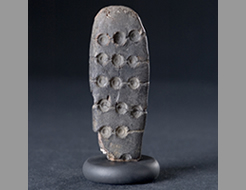|
||||||||||||||||||||||||||||||||
|
|
Museum of: Rome | |||||||||||||||||||||||||||||||
| Name of the artefact: Enigmatic tablets from Polada 3 | ||||||||||||||||||||||||||||||||
|
These tablets with impressions (tallies? tokens?)
called “loaf-of-bread idols” or “enigmatic tablets” come from the
lakeside dwellings of Polada, explored from the ninetenth century. |
||||||||||||||||||||||||||||||||
|
WHERE IS IT AND MAIN CHARACTERISTICS |
STATE |
|||||||||||||||||||||||||||||||
|
Department: |
- |
Preservation: |
Good | |||||||||||||||||||||||||||||
|
Inventory number: |
61245 |
Restauration: |
Restored | |||||||||||||||||||||||||||||
|
Name of the artefact: |
Enigmatic tablets from Polada 3 |
Completeness: |
Almost Complete | |||||||||||||||||||||||||||||
|
Object type: |
Other |
|||||||||||||||||||||||||||||||
|
Material: |
Clay |
|||||||||||||||||||||||||||||||
|
Methof of manufacture: |
Hand made |
|||||||||||||||||||||||||||||||
|
Decoration type: |
No decoration |
|||||||||||||||||||||||||||||||
|
Distinctive mark: |
- |
|||||||||||||||||||||||||||||||
|
DIMENSIONS |
PERIOD OF USE |
|||||||||||||||||||||||||||||||
|
Length (mm): |
- |
Epoque: |
Bronze Age |
|||||||||||||||||||||||||||||
|
Heigth
(mm): |
66 |
Culture: |
Polada |
|||||||||||||||||||||||||||||
|
Diameter
(mm): |
- |
Period: |
Early Bronze Age |
|||||||||||||||||||||||||||||
|
Width (mm): |
24 |
Face: |
- |
|||||||||||||||||||||||||||||
|
Thickness (mm): |
- |
Absolute chronology: |
2000-1800 BC |
|||||||||||||||||||||||||||||
|
Weight
(g): |
- |
|||||||||||||||||||||||||||||||
DISCOVERY |
||||||||||||||||||||||||||||||||
|
Date: |
End 1800s |
Country: |
Italy |
|||||||||||||||||||||||||||||
|
District: |
Lombardia |
Town hall affiliation: |
Brescia |
|||||||||||||||||||||||||||||
|
Village: |
Lonato |
Discovery findspot: |
Polada |
|||||||||||||||||||||||||||||
|
Condition of discovery: |
Chance Discovery |
Discovery type: |
Dwelling |
|||||||||||||||||||||||||||||
|
ANALYSES – DETERMINATIONS |
FILLED IN BY |
|||||||||||||||||||||||||||||||
|
Type: |
- |
Name: |
Chiara Delpino |
|||||||||||||||||||||||||||||
|
Laboratory: |
- |
Institution: |
- |
|||||||||||||||||||||||||||||
|
No./Code: |
- |
Date: |
10-2005 |
|||||||||||||||||||||||||||||
|
DEEPENINGS |
||||||||||||||||||||||||||||||||
|
Morphology of the object: |
||||||||||||||||||||||||||||||||
|
Convex section rectangular shaped clay tablet with
circular indentations symbol impressions. On the convex side are deep
impressed six transversal rows of different size dots linked in colums
by incised lines. |
||||||||||||||||||||||||||||||||
|
Decoration: |
||||||||||||||||||||||||||||||||
|
Convex section rectangular shaped clay tablet with
circular indentations symbol impressions. On the convex side are deep
impressed six transversal rows of different size dots linked in colums
by incised lines. |
||||||||||||||||||||||||||||||||
|
Inscription: |
||||||||||||||||||||||||||||||||
|
- |
||||||||||||||||||||||||||||||||
|
Analogies: |
||||||||||||||||||||||||||||||||
|
The tablets found in Italy were recovered in Early and
Middle Bronze Age settlements, mainly in the area of the Pianura Padana.
Across central and eastern Europe similar tablets have been recovered in
both settlements and necropolis dating back to the Early and Middle
Bronze Age. The number of marks as well as the types of incision present
on each tablets varies, but is however possible to notice a wider
presence of tablets with lines during the Early Bronze Age, presence
that decreses during the Middle Bronze Age. There is also a variety in
the number of marks present on each line, from one to twenty: throughout
the Early Bronze Age onto the Middle Bronze Age is attested a
progressive decrease in the number of marks while there is an increase
in the variety of symbols (cuppelle, rectangles, cuppelle and dots,
cuppelle and crosses, triangles, crosses, dots, rhumbs, four-leaved
clover, spirals). Only one symbol is present on most of the tablets,
mostly cuppelle, and never more than three on the same tablet. |
||||||||||||||||||||||||||||||||
|
Interpretation: |
||||||||||||||||||||||||||||||||
|
The so called “enigmatic tablets” have attracted the
attention of scholars since the end of the 1800s. Different
interpretations have been suggested regarding the use and the meaning of
these objects: for example, according to some scholars, the
interpretation of the incisions as cyclic symbols, such as the phases of
the moon, could suggest the use as a sort of calendar. Other scholars
have linked the tablets to a way of communication across Europe
attesting the circulation of exchanged gifts or trade activities
especially linked to amber. The tablets are however interpreted by most
scholars as part of a cult practice, linked to magical-religious rituals. |
||||||||||||||||||||||||||||||||
|
Bibliography: |
||||||||||||||||||||||||||||||||

